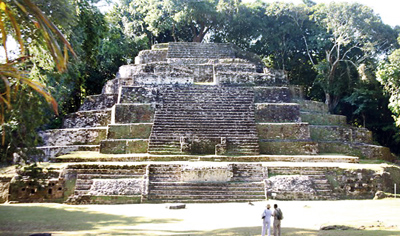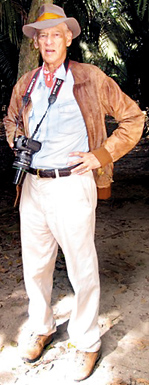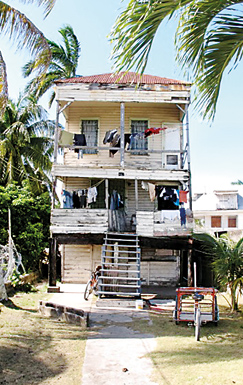The lure of the jungles of Belize
Ever since reading Paul Theroux’s spell-binding but also terrifying 1981 adventure story Mosquito Coast about an American family that find a simpler life in the jungles of Central America I have desperately wanted to go to Belize, formerly British Honduras. It is on the north-eastern coast of Central America. The mainland is about 180 miles long, 68 miles wide, and is bordered to the north by Mexico and to the south and west by Guatemala. There are still only a little over 312,000 inhabitants – the lowest population density in Central America.

Actually it is the jungles of Belize that lured me to them, but to get there one must first go to Belize City. It is quite a shock when you first see the town, with its narrow congested streets, decrepit wooden structures that stand right up to road edges, and stagnant canals still used for drainage. It really does look as though the City is recovering from some horrible calamity. This is partly true, as there have been several devastating hurricanes, particularly Hurricane Hattie in October 1967 that tore the City apart with winds of up to 150 mph leaving behind only a thick layer of mud. The 76,000 inhabitants represent every ethnic group in the country. Creoles, descendants of former slaves, and British Baymen – the descendants of 16th century British buccaneers – form the dominant population element. It is a very Caribbean atmosphere. Food vendors jostle for pavement space and dope is often smoked openly in the streets.
After a brief visit we drove on the Northern Highway back to a humble Roadside Diner where we were encouraged to have some local food. Gibnut, rice and beans. Gibnut is a local delicacy – a nocturnal rodent. It was delicious. Particularly washed down with some local Pelican beer. In fact the Queen, asking for something Belizean,was given Gibnut to eat on her last 1994 visit to Belize. She wasn’t told what she had eaten until after the meal. She hasn’t been back to the country since.

Enjoying the rainforest: Sir Christopher Ondaatje
After lunch and another hour’s drive we reached the New River from where we were ferried to Lamanai Outpost Lodge. Raul Manzanilla, our guide, pointed out a host of Central American birds during the blazing hot trip – some of which I had never seen before: Snail Kites, Great White Egrets, Osprey, Glossy Ibis, Black Vultures, and various Kingfishers. We arrived at our destination late in the afternoon and were guided to one of 15 thatched cabins overlooking a lake adjoining the New River – a jungle paradise, totally secluded. We rested, but there was little time for relaxation because after a hasty Belizean dinner we embarked on a two hour night boat safari – a wonderful experience searching out nocturnal birds and mammals with a spotlight: more Snail Kites, a solitary Limpkin, a very large crocodile – easily over 10 feet in length. The temperature dropped considerably, particularly when speeding across the lake and narrows.
Early next morning, through troops of endangered Black Howler monkeys and swarms of aggressive mosquitoes – we made our way through ancient Ceiba trees to the Lamanai temple complex which sits on the western bluff of the New River lagoon only a short walk away.
Lamanai was occupied by the Mayans continuously for over 3000 years. Its remoteness contributed to is continuous occupation – well beyond other Mayan sites, until at least 1650 AD. Although hundreds of ruins are said to remain unexcavated in the nearby jungle, three of the most impressive temples have been restored: the Jaguar Temple, named for its boxy jaguar decoration; the Mask Temple, adorned by a 13 foot stone mask of an ancient Mayan king; and the High Temple offering incredible panoramic views from its summit. The tiny on-site museum crowds a fascinating collection of impressive Mayan artifacts depicting Mayan gods and animals.
The Black Howler monkeys, among the largest primates in the Neotropics, make the forests around the Lamanai ruins their home and their loud territorial howling calls gave us a magnificent morning chorus. They could be heard two miles away. Only the dominant male did the howling while the browner protected females either nursed their young or gave out much weaker grunts. We must have seen 20 or 30 of the monkeys with their long prehensile tails displaying acrobatic and quite sensual feats. A pair of keel-billed Toucans – the national bird of Belize – flitted over us. The extraordinary bird is 17-22 inches long, and its colourful bill is one third of its length. We were lucky. A social bird, it is only found in the lowland rainforests.

An old Belize house and top, the Lamanai Mayan ruins
That afternoon we drove six miles out of the rain forest to the Baptist Mennonite Community that edges the jungle. It was a shock to suddenly come across extraordinarily lush cleared farmlands that had been cleared by the Anabaptist sect named after the Dutch priest Menno Simon in the 16th century. Because of their pacifist objection to military service they had been forced to move to Switzerland, then to Prussia, and in 1663 to Russia.
The fiercely religious sect were then forced to move to North America, Mexico and finally in 1958 to British Honduras – a country desperate for settlers. There are now over 10,000 conservative Mennonites in Belize. Hard workers, they have contributed substantially to the agriculture of the country, turning tropical jungle into productive farmland. They are easily recognisable with their denim dungarees and white straw hats. Women wear dark long dresses and head covering. Their houses are tidy and simple and they travel in horse-drawn carts. Nevertheless they have been severely criticised that their agricultural prosperity has been achieved without regard for environmental laws, and that they have ruthlessly killed protected species like the jaguar which raid their cattle. Mark Howell, who owns and runs the Lamanai Lodge, showed me a night film clip of a large male jaguar eating one of his victims. The beast is known to have killed 26 cattle. We looked in vain for the beautiful nocturnal cat although we did see fresh droppings and some recent territorial markings on trees.
There are 56 different species of snakes in Belize, but only eight are considered dangerous to humans. Therefore when we went on walking safaris we were particularly careful where we put our feet. The narrow rough paths seemed safe enough – but the jungle floor with its mottled shades of dark and light required particular caution. Apart from looking for jaguar tracks, we saw more Howler monkeys, White Tailed Deer, Great Curassow birds and both the rare Boat-billed Heron and the Tiger Heron. Needless to say we continued to be plagued by mosquitoes. No amount of insect repellent seemed to keep them away.
We revisited the Mayan Jaguar temple again through a separate path in the rain forest, and came across an old 1856 sugar mill now in ruins with trees growing through its brick foundations. It is rumoured that the British owner paid his workers in rum rather than currency – with the inevitable disastrous consequences.
All too soon our short Belize jungle experience ended with another beautiful boat journey back down the New River and then to the Belize City airport by road. What a change from the seclusion of the rain forest – away from the wildlife excitement and the warm friendly Belizean staff. And their exotic Central American cooking. Despite the difficulty getting there Lamanai must surely be one of the most unique get-away havens for fishing, ruin exploration, night safaris, crocodile encounters, and even jaguar tracking. I was homesick for the Belizean jungles even before I had left them.
comments powered by Disqus

